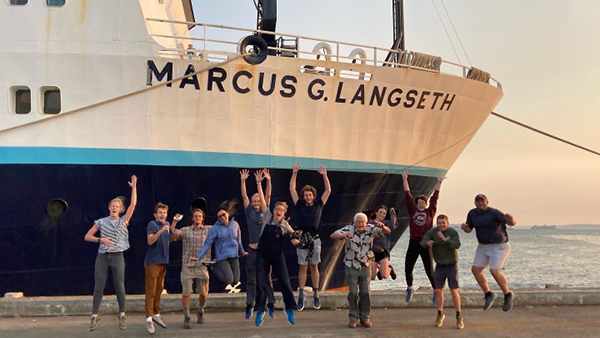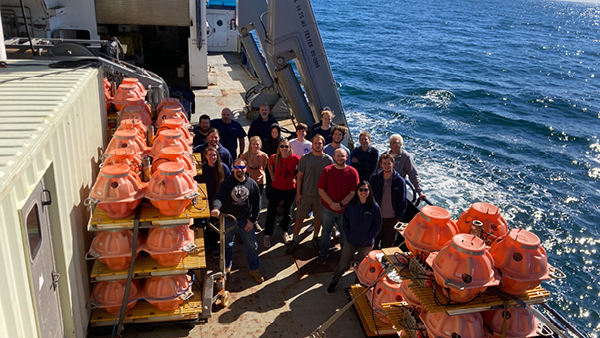Charting New Territory
December 5, 2022 - Irene Gray
 One of the world’s most seismically-active faults has produced six earthquakes with a magnitude of seven or greater in the last century alone – yet very little is known about it. Regents’ Lecturer, Lindsay Lowe Worthington, and her team have set out to learn more about the mysterious Queen Charlotte fault, which sits under the ocean off the coast of Alaska, and their research has now made it one of the best-imaged faults in the world.
One of the world’s most seismically-active faults has produced six earthquakes with a magnitude of seven or greater in the last century alone – yet very little is known about it. Regents’ Lecturer, Lindsay Lowe Worthington, and her team have set out to learn more about the mysterious Queen Charlotte fault, which sits under the ocean off the coast of Alaska, and their research has now made it one of the best-imaged faults in the world.
As the first comprehensive study of its kind to image this plate boundary which stretches approximately 900 km (or 560 miles), Worthington and her colleagues from Western Washington University and Dalhousie University in Canada, are spending weeks at a time on a ship to collect data that will help them predict future earthquakes and tsunamis in the area, as well as provide data to understand similar fault lines such as the San Andreas Fault in California.
“Our goal is to characterize the structure and tectonic framework of the area to further understand current deformation, seismicity and hazards along the fault. For such an active plate boundary, so little is known about the structure—we are definitely charting new territory!”
 As the chief scientist on the ship, Worthington is leading a team, or “science party” as they’re referred to on the ship, of approximately 25 scientists and future scientists at a time for weeks-long expeditions to gather data. Six graduate students had the opportunity to experience this field work opportunity of a lifetime, with two of them being from UNM.
As the chief scientist on the ship, Worthington is leading a team, or “science party” as they’re referred to on the ship, of approximately 25 scientists and future scientists at a time for weeks-long expeditions to gather data. Six graduate students had the opportunity to experience this field work opportunity of a lifetime, with two of them being from UNM.
“Working on the R.V. Marcus G. Langseth must be the most rewarding experience of my Ph.D. studies here at UNM. The privilege to work with highly trained specialists and crew members aboard the vessel helped me to understand the importance of multilateral collaboration in the pursuit of a groundbreaking goals,” said Olumide ‘Olu’ Adedeji, a PhD candidate in Earth & Planetary Sciences.
After several setbacks due to the pandemic, they were finally able to set out on their first trip on July 17, 2021 aboard two ships: the Marcus G. Langseth, a research ship operated by Columbia University and the National Science Foundation; and a Canadian Coast Guard Vessel, the John P. Tully.
For the next 40 days, scientists aboard the Tully deployed ocean bottom seismometers (OBS) to the sea floor that were able to track the sound source from airguns strung behind the Langseth. Air bubbles produce sound waves from these streamers, enabling the scientists to create detailed images of the fault line. Additional equipment within the streamers traced the earth’s crust.
The significance of this data cannot be understated. Large earthquakes occur between tectonic plates within the Earth’s crust and the Queen Charlotte fault line sits between two plates: the Pacific and the North American. When these two plates slide against the fault, earthquakes occur. By mapping the fault and tracing the crust, Worthington’s team are enabling researchers to better understand when and how future earthquakes and tsunamis will occur.
Weeks at sea involve long days which can often be interrupted by the wildlife surrounding them. In accordance with international, Federal, and state protocols, the team ceased operations when sea life was detected in the area to ensure that they were not harmed by the equipment.
 While many of the OBS were recovered during the initial expedition, 28 were left behind to continue tracking data over the course of the next year. Lowe Worthington and her team recovered the remaining equipment in the Fall of 2022.
While many of the OBS were recovered during the initial expedition, 28 were left behind to continue tracking data over the course of the next year. Lowe Worthington and her team recovered the remaining equipment in the Fall of 2022.
From here, the team will analyze the data they’ve recovered over the next few months in preparation for the next phase of their project which will be communicating the data to the communities surrounding the fault line. This outreach will begin in the Summer of 2023 to enable these communities to implement better hazard assessment and earthquake protocols.
“We are happily up to our ears in data and are working hard to produce new images of the fault that will be important for understanding earthquake behavior and the overall tectonic framework of much of the northwestern North American continent.”
To learn more about this project and the impact it is making on our understanding of fault lines such as the Queen Charlotte, go to qcfgeohazards.squarespace.com.
